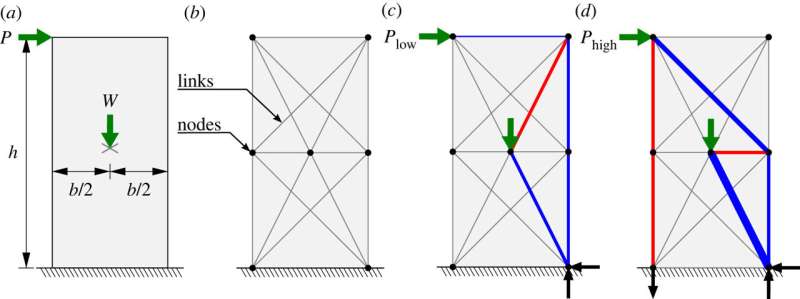
A new engineering technique that could help to preserve historic stone buildings and bridges has been developed by researchers at the University of Sheffield.
The method, developed by a team of researchers from the University’s Department of Civil and Structural Engineering, provides a new, more accurate way of assessing how stone and brick masonry constructions—including medieval cathedrals and Victorian railway viaducts—can safely carry applied forces.
This new approach could mean that more masonry structures are restored and used long into the future, rather than demolished and replaced.
Since the late 1600s, engineers have used the ‘thrust line method’ to assess the safety of masonry buildings and bridges, developed by famous scientist Robert Hooke. However, the traditional thrust line method has limitations. For example, it requires an engineer to exercise careful judgment when assessing the safety of masonry constructions containing openings and also neglects the possibility of failure due to sliding. Furthermore, it is often not clear which areas of masonry are required to possess some tensile capacity—the ability to be stretched or pulled before breaking.
The approach developed at Sheffield overcomes these limitations and can be applied to masonry constructions of any geometry, with or without openings. The method also explicitly identifies regions in structures where some tensile capacity is needed.
The technique, called thrust layout optimization, is a natural extension to the famous model of masonry Hooke devised in 1675, offering valuable new insights into the behavior of masonry constructions. The researchers have also developed open source software that, with further development, will allow practicing engineers and architects to assess the safety of stone and brick masonry constructions.
Research team leader Professor Matthew Gilbert, Professor of Civil Engineering at the University of Sheffield, said, “Stone and brick masonry has been used for millennia to form buildings and bridges ranging in scale from humble dwelling houses to cathedrals and railway viaducts. Many of these structures have considerable historic value, and, to ensure they remain safe and fit for purpose, effective assessment methods are required.”
“A long-running problem is that the ways in which applied forces are successfully transmitted down to the ground in masonry structures are often not intuitively obvious, so digital tools that help explain this to engineers are potentially invaluable.”
“The current climate crisis also makes it particularly important that engineers have access to efficient and reliable tools to assess the safety of existing masonry constructions—helping to ensure that these can be used long into the future, rather than being needlessly demolished and replaced.”
Lead author Isuru Nanayakkara, a research student at the University of Sheffield, said, “There has been a resurgence in interest in using stone in construction, as it’s a low embodied carbon material—however, suitable digital analysis and design tools are needed to translate this interest into more widespread use.”
“Currently, engineers have been turning to analysis and design tools that are better suited for steel and concrete structures, which means that steel reinforcement is sometimes being used in new masonry designs when it’s not needed. We hope that our new thrust layout optimization technique can help here—we’re making available open-source software for interested structural engineers and architects and we welcome their feedback on this.”
The thrust layout optimization method is described in a new paper, entitled Application of thrust layout optimization to masonry structures, published in the journal Proceedings of the Royal Society A.
More information:
K. Isuru U. Nanayakkara et al, Application of thrust layout optimization to masonry structures, Proceedings of the Royal Society A: Mathematical, Physical and Engineering Sciences (2023). DOI: 10.1098/rspa.2023.0053
Citation:
Historic stone buildings and bridges could be preserved by new engineering technique (2023, May 22)
retrieved 22 May 2023
from https://techxplore.com/news/2023-05-historic-stone-bridges-technique.html
This document is subject to copyright. Apart from any fair dealing for the purpose of private study or research, no
part may be reproduced without the written permission. The content is provided for information purposes only.
Stay connected with us on social media platform for instant update click here to join our Twitter, & Facebook
We are now on Telegram. Click here to join our channel (@TechiUpdate) and stay updated with the latest Technology headlines.
For all the latest Technology News Click Here
For the latest news and updates, follow us on Google News.
